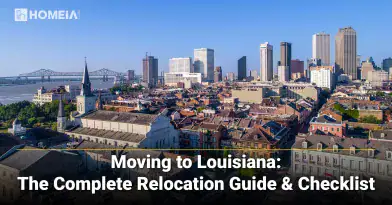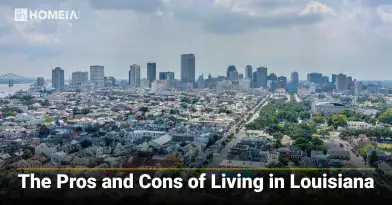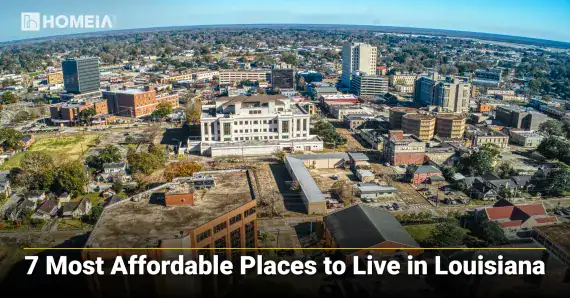The 5 Best Places to Live in Louisiana: A City Comparison
- Local Editor:Local Editor: The HOMEiA Team
Published: Oct 27, 2025
- Category: City Living Guide

Louisiana is a state of vibrant contrasts, where French colonial history meets modern industry and swampy wilderness borders bustling urban centers. Choosing the right community is crucial to unlocking a lifestyle that fits your ambitions, no matter the goal.
This guide provides an in-depth, data-driven analysis of the five best places to live in Louisiana in 2025. We’ve moved beyond simple charm to evaluate these population centers on the factors that matter most: economic opportunity, affordability, safety, access to amenities, and unique quality of life. From the high-energy vibe of New Orleans to the serene suburban comfort of Lafayette, we break down what makes each city a premier destination for building your future in the Deep South.
For those considering other states, you might also explore our comparison of the pros and cons of living in Tennessee.
Table of Contents:
Key Takeaways
- Diverse Options for Diverse Needs: These top cities offer distinctly different lifestyles, from the cultural epicenter of New Orleans to the stable, family-friendly environment of Bossier City.
- Affordability is a Constant: A major advantage across all five cities is a cost of living at or below the national average, with accessible housing costs compared to other Southern states.
- Safety Varies Significantly: Safety ratings range from sheltered to underperforming, making it crucial to research specific neighborhoods and cities based on your personal tolerance and priorities.
- Economic Drivers Differ: Each city’s job market is anchored by a different sector—tourism, energy, military, education, or healthcare—requiring alignment with your career field.
- Culture is Key: The intangible sense of place, community, and access to culture and nature are often the defining factors in choosing between these exceptional locations.
I. Methodology: How We Chose the Best
To ensure a comprehensive and objective ranking, our analysis is based on a multi-factor methodology that evaluates each city on key criteria essential for quality of life in the Louisiana context.
Our evaluation criteria are weighted as follows:
- Employment & Economy (25%): Assesses job market health, major employers, economic diversity, and income levels relative to the local cost of living.
- Housing & Affordability (25%): Evaluates median home value, average rent, and home-price-to-income ratios, acknowledging Louisiana’s overall affordability but important local variations.
- Quality of Life & Culture (20%): Encompasses access to unique outdoor recreation, cultural attractions, dining, entertainment, and overall lifestyle.
- Access & Infrastructure (15%): Considers connectivity (road, air), healthcare access, internet reliability, and other critical services.
- Safety & Community (15%): Reviews crime statistics and overall community engagement, resilience, and family-friendliness.
Data is compiled from reputable 2025 sources, including the U.S. Census Bureau, Bureau of Labor Statistics, FBI crime data, and real estate market analyses (Zillow, local MLS).
Our Methodologies to create HOMEiA Score Ratings for Each Group of Content
HOMEiA uses a consistent, data-driven methodology to evaluate U.S. states for livability, affordability, and long-term value. Our analysis centers on key factors such as Housing and Affordability, Cost of Daily Living, Access and Infrastructure, Community Strength, Safety and Quality of Life, Economic Resilience and Job Market Performance…
II. The 5 Best Cities: A Portrait of Louisiana’s Diversity
1. New Orleans: The Cultural Epicenter
HOMEiA Score: 79/100
- Cost of Living: 2% below U.S. average
- Monthly Rent: $1,350
- Home price to income ratio: 7.2:1
- Income to rent ratio: 44.4x
- Safety rating: 38/100
A. Employment & Economy: New Orleans’ economy has transformed significantly since Hurricane Katrina, with tourism remaining the cornerstone. Diversification into healthcare, education, and tech lead while digital media and renewable energy are right behind. Tulane and Loyola universities anchor the education sector, and healthcare represents one of the largest employers. The unique blend of established industries and new economic positions creates a dynamic, if sometimes challenging, job market.
B. Housing & Affordability: New Orleans presents the most complex housing market in Louisiana, with the home-price-to-income ratio at 7.2:1 reflecting high demand from tourists, students, and new residents. Here is highly neighborhood-dependent, from historic French Quarter properties to flooded-and-rebuilt areas. Limited land and historic preservation create supply constraints, while short-term rentals impact long-term housing availability. However, compared to other major cultural cities, New Orleans remains relatively affordable.
C. Quality of Life & Culture: The Big Easy offers an unparalleled cultural experience, from world-famous music and cuisine to historic architecture and annual celebrations including Mardi Gras and Jazz Fest. Neighborhoods each have distinct characters, from the Garden District’s mansions to Marigny’s bohemian vibe. Despite infrastructure challenges, their spirit, creativity, and resilience create a unique living experience that attracts people worldwide. Access to the Mississippi River, swamps, and Gulf Coast provides diverse outdoor opportunities.
D. Access & Infrastructure: Louis Armstrong International Airport (MSY) provides global connectivity, while I-10 offers road access. The city’s infrastructure faces ongoing challenges from geography and aging systems, though significant post-Katrina investments improved flood protection and utilities. Healthcare access is excellent with multiple major hospitals, and the streetcar system provides historic charm alongside practical transportation while still being walkable.
E. Safety & Community: With a safety rating of 38/100, NOLA requires careful neighborhood selection and urban awareness. The community is famously resilient and creative, with distinct neighborhood identities and cultural traditions. The population blends multi-generational families, students, artists, and newcomers, creating a dynamic social fabric. While crime rates are concerning, neighborhoods have active community groups and social networks to enhance safety and quality of life.
Moving to Louisiana: The Complete Relocation Guide & Checklist
Louisiana, bordered by Texas, Arkansas, and Mississippi, offers rich culture, natural beauty, and diverse heritage. Home to over 4.5 million people, it blends French, Spanish, African, and Caribbean influences. With affordable living, no state tax on Social Security, and a festive spirit, Louisiana welcomes newcomers with warmth and vibrancy.
2. Baton Rouge: The Capital Hub
HOMEiA Score: 82/100
- Cost of Living: 8% below U.S. average
- Monthly Rent: $1,050
- Home price to income ratio: 4.8:1
- Income to rent ratio: 52.4x
- Safety rating: 45/100
A. Employment & Economy: Baton Rouge serves as Louisiana’s political and economic capital, anchored by state government operations and Louisiana State University. Heavily influenced by the petrochemical industry, major refineries and chemical plants along the Mississippi River provide stable, high-paying jobs. Healthcare has emerged as another powerhouse, with Our Lady of the Lake Regional Medical Center and Baton Rouge General among the largest healthcare providers. LSU brings academic and research opportunities, creating a diverse employment base more resilient than many LA cities.
B. Housing & Affordability: Baton Rouge offers one of the best housing values among major cities. The home-price-to-income ratio of 4.8:1 indicates flexible purchasing power for residents. The market provides a mix of historic homes in established neighborhoods including Spanish Town and newer developments in suburban areas like Shenandoah. While more expensive than smaller cities in the state, Baton Rouge remains budget-friendly compared to other state capitals, with a cost of living 8% below the national average.
C. Quality of Life & Culture: Life combines Southern charm with urban amenities. Known forCajun and Creole cuisine, vibrant LSU sports culture, and access to the Mississippi Riverfront, cultural attractions include the Shaw Center for the Arts, Louisiana Art & Science Museum, and numerous festivals throughout the year. Outdoor enthusiasts enjoy the Bluebonnet Swamp Nature Center and nearby plantation tours, while food lovers appreciate the city’s emerging restaurant scene beyond traditional fare.
D. Access & Infrastructure: As the state capital, BR enjoys robust infrastructure with major interstate connections (I-10, I-12) and Baton Rouge Metropolitan Airport (BTR). The city has multiple hospital systems and reliable utilities, though traffic congestion can be challenging during peak hours. Public transportation exists but is limited, making personal vehicles essential for most residents. It serves as a regional hub for healthcare, education, and government services for surrounding parishes.
E. Safety & Community: With a safety rating of 45/100, there exist urban challenges typical of many state capitals. Safety varies significantly by neighborhood, with protected areas like the Garden District and University Lakes area contrasting with higher-crime districts. With a diverse community, there exists both government and academia creating an educated, engaged population. Neighborhood associations are active, and community events like the annual Red Stick Farmers Market foster local connections.
Recommended for you
3. Lake Charles: The Energy and Recreation Hub

HOMEiA Score: 83/100
- Cost of Living: 9% below U.S. average
- Monthly Rent: $1,000
- Home price to income ratio: 4.2:1
- Income to rent ratio: 54.0x
- Safety rating: 52/100
A. Employment & Economy: Lake Charles serves as a major energy and industrial center, with one of the largest concentrations of chemical plants and LNG export facilities in the United States. This industrial base provides high-wage opportunities and economic stability, though vulnerable to energy market fluctuations. Diversification into gaming, with several major casinos, and healthcare through the Christus Ochsner Health System has occurred.
B. Housing & Affordability: LC offers strong value with a cost of living 9% below the national average. The home-price-to-income ratio of 4.2:1 indicates exceptional purchasing power, particularly given the area’s high industrial wages. Their housing market features a mix of established neighborhoods and new construction, though recent hurricane damage has affected supply. Rebuilding efforts improved construction standards and flood resilience.
C. Quality of Life & Culture: Life balances industrial might with natural beauty, situated between the Calcasieu River and numerous lakes. The city offers fishing, boating, and outdoor recreation, complemented by a vibrant casino and entertainment district. Cultural attractions include the Mardi Gras Museum and historic Charpentier District, while the culinary scene blends Cajun traditions with modern influences. The community maintains strong ties to the Boot culture and the industrial workforce.
D. Access & Infrastructure: Lake Charles Regional Airport (LCH) provides convenient connections, while I-10 makes travel to Houston and Lafayette straightforward. There exists modern industrial infrastructure with significant investments in post-hurricane rebuilding. Healthcare facilities are excellent for the city’s size, and the industrial base ensures reliable utilities. The city’s location makes it a natural gateway between Louisiana and Texas.
E. Safety & Community: With a safety rating of 52/100, Lake Charles offers a comfortable living environment with some urban challenges. The community is tightly-knit to both the industrial workforce and traditional culture. Neighborhood quality varies, with well-maintained areas near the lakes and universities contrasting with more challenged districts. Resilience through multiple hurricanes strengthened community bonds and fostered a practical, supportive atmosphere.
The Pros and Cons of Living in Louisiana
Louisiana is more than jazz, Creole flavors, and the French Quarter—it’s a state defined by rich culture, warm hospitality, and a laid-back lifestyle. However, living here means facing challenges like hurricanes, humidity, and economic hurdles. This guide explores Louisiana’s pros and cons and its best cities for every lifestyle.
4. Lafayette: The Heart of Cajun Country
HOMEiA Score: 84/100
- Cost of Living: 12% below U.S. average
- Monthly Rent: $950
- Home price to income ratio: 4.5:1
- Income to rent ratio: 56.3x
- Safety rating: 58/100
A. Employment & Economy: Lafayette’s economy has historically been driven by the oil and gas industry, serving as the hub for the state’s offshore operations. While still significant, the energy sector has diversified into healthcare (specifically the Ochsner Lafayette General system) and education (University of Louisiana at Lafayette). Work has been done to attract technology and service companies, creating a more balanced economic base. Their position as the center of Acadiana makes it a regional commercial hub for surrounding parishes.
B. Housing & Affordability: Here offers exceptional value with a cost of living 12% below the national average—the most affordable on our list. The home-price-to-income ratio of 4.5:1 indicates unmatched purchasing power. Housing options feature a mix of traditional architecture and modern subdivisions, all at prices that make homeownership accessible to young professionals and families. Recent economic diversification has helped maintain housing stability even during energy sector fluctuations.
C. Quality of Life & Culture: Being the cultural capital of Cajun Country means offering an authentic, unrivaled experience. The city pulses with zydeco music, world-class Cajun and Creole cuisine, and festivals like Festival International de Louisiane. The U of L brings youthful energy and cultural events, while the downtown area has experienced significant revitalization. Outdoor enthusiasts enjoy nearby swamps and bayous, while community upbringing gives off large town vibes rather than a small city.
D. Access & Infrastructure: Lafayette Regional Airport (LFT) provides convenient connections, while I-10 makes travel to Baton Rouge and Lake Charles straightforward. The city has modern healthcare facilities and reliable infrastructure, though some areas face drainage challenges common in South Louisiana. Its compact size makes navigation easy, and the city has invested in improving roads and public spaces. As the hub of Acadiana, it offers all the amenities of a much larger city.
E. Safety & Community: With a safety rating of 58/100, it offers a comfortable living environment with neighborhood-specific variations. The community is famously welcoming, with deep cultural roots defining the social fabric. Neighborhoods like River Ranch showcase planned community living, while established areas maintain their historic character. The strong Catholic influence and multi-generational families create a stable, connected community that values tradition and hospitality.
7 Most Affordable Places to Live in Louisiana
Louisiana combines Southern charm with surprising affordability, offering a lower median home price and no state tax on Social Security income. This guide highlights seven of the most budget-friendly Louisiana communities for 2025, analyzing housing, utilities, and transportation to help you find the perfect balance of cost and lifestyle.
5. Bossier City: The Family-Friendly Alternative

HOMEiA Score: 85/100
- Cost of Living: 10% below U.S. average
- Monthly Rent: $1,100
- Home price to income ratio: 3.9:1
- Income to rent ratio: 59.1x
- Safety rating: 68/100
A. Employment & Economy: Bossier City’s economy is closely tied to its larger neighbor, Shreveport, and the massive Barksdale Air Force Base. It provides stable, well-paying roles and supports a robust defense contractor presence. Gaming represents another major economic pillar, with several casinos along the Red River attracting visitors. Healthcare, education, and retail round out an economy that has proven resilient through regional economic shifts.
B. Housing & Affordability: Bossier City offers newer housing stock and modern infrastructure at prices that remain below national averages. The high median income relative to housing costs results in a home-price-to-income ratio of 3.9:1—the best on our list for purchasing power. Options are predominantly suburban-style homes with ideal schools and family-friendly amenities. Its cost of living, at 10% below average, makes it an attractive option for military families and young professionals.
C. Quality of Life & Culture: Life in BC emphasizes family-friendly amenities and convenience. Here exists exceptional parks, community centers, and recreational facilities alongside the entertainment options of the casino district. The Louisiana Boardwalk provides shopping and dining with river views, while proximity to Shreveport ensures access to cultural institutions without urban challenges. Outdoor activities abound at nearby lakes and parks, and military presence creates a patriotic, community-oriented atmosphere.
D. Access & Infrastructure: Fully integrated with the Shreveport metropolitan area, residents enjoy smooth connectivity via I-20 and I-49. Shreveport Regional Airport (SHV) provides air travel options, while the city itself has modern utilities and emergency services. The infrastructure benefits from consistent growth and military investment, with well-maintained roads and public facilities. Healthcare access is renowned, with multiple hospital systems serving the region.
E. Safety & Community: With a safety rating of 68/100, it ranks as one of Louisiana’s safest larger communities. The city maintains low crime rates and well-maintained neighborhoods, tied to military and civilian life. Family-oriented activities, youth sports, and community events foster engagement, while the stable population (many military families stay for multiple assignments) creates lasting neighborhood connections. For those considering other states with great schools, explore the best places to live in Texas.
Comparative Data Table
City | HOMEiA Score | Cost of Living | Avg. Rent (2-Bed) | Home Price to Income Ratio | Income to Rent Ratio | Safety Rating |
|---|---|---|---|---|---|---|
| New Orleans | 79 | -2% | $1,350 | 7.2:1 | 44.4x | 38 |
| Baton Rouge | 82 | -8% | $1,050 | 4.8:1 | 52.4x | 45 |
| Lake Charles | 83 | -9% | $1,000 | 4.2:1 | 54.0x | 52 |
| Lafayette | 84 | -12% | $950 | 4.5:1 | 56.3x | 58 |
| Bossier City | 85 | -10% | $1,100 | 3.9:1 | 59.1x | 68 |
Conclusion: Finding Your Perfect Louisiana Match
The best Louisiana city is subjective. Baton Rouge delivers political and educational opportunities, while Lafayette offers authentic Cajun culture and affordability. Bossier City promises safety and family amenities, and Lake Charles provides industrial jobs and outdoor recreation. New Orleans offers unmatched culture and energy for those who can navigate its challenges.
Each location presents a unique trade-off between cost, opportunity, and lifestyle. Your ideal choice hinges on aligning these factors with personal, financial, and professional goals for life on The Boot. For those still considering options, our guide to the best places to live in Mississippi might provide additional insights for Southern living.
Recommended for you
FAQs About Living in Louisiana’s Best Cities
1. Which city has the best job market for energy professionals?
Lake Charles has the strongest concentration of energy and industrial jobs, particularly in LNG and petrochemicals. Baton Rouge also offers significant opportunities in refining and chemical manufacturing along the Mississippi River corridor.
2. I’m a remote worker. Where should I move in Louisiana?
For the best blend of reliable infrastructure, amenities, and culture, Lafayette offers excellent value and authentic Louisiana living. For urban energy with cultural amenities, New Orleans provides unique inspiration, though internet reliability can vary by neighborhood. Always confirm internet service availability at your specific address before moving.
3. Are these cities safe from hurricanes?
All Louisiana cities face hurricane risk, but some are more vulnerable than others. Lake Charles has experienced significant recent hurricane impacts, while New Orleans has unique flood protection challenges. Bossier City and areas north of I-10 generally face lower storm surge risk. All residents should have hurricane preparedness plans.
HOMEiA is a city guide site where visitors can find detailed information about communities of interest. HOMEiA’s City Guides, created in partnership with local writers and editors, are curated lists of the best, safest, and most affordable places to live. The guides feature the HOMEiA Score, a proprietary index that rates communities on such factors as housing costs, education, employment, etc.
HOMEiA.com aims to be the premier site for people planning to relocate, providing them with insightful content and connecting them with skilled real estate professionals.
We also empower real estate professionals to establish or strengthen their web presence by highlighting their experience, knowledge and achievements. If you’re selected to join our list of certified real estate professionals, you will distinguish yourself from your peers — and earn HOMEiA’s support.
If you believe in HOMEiA’s mission, please share our website with others.







































































































































